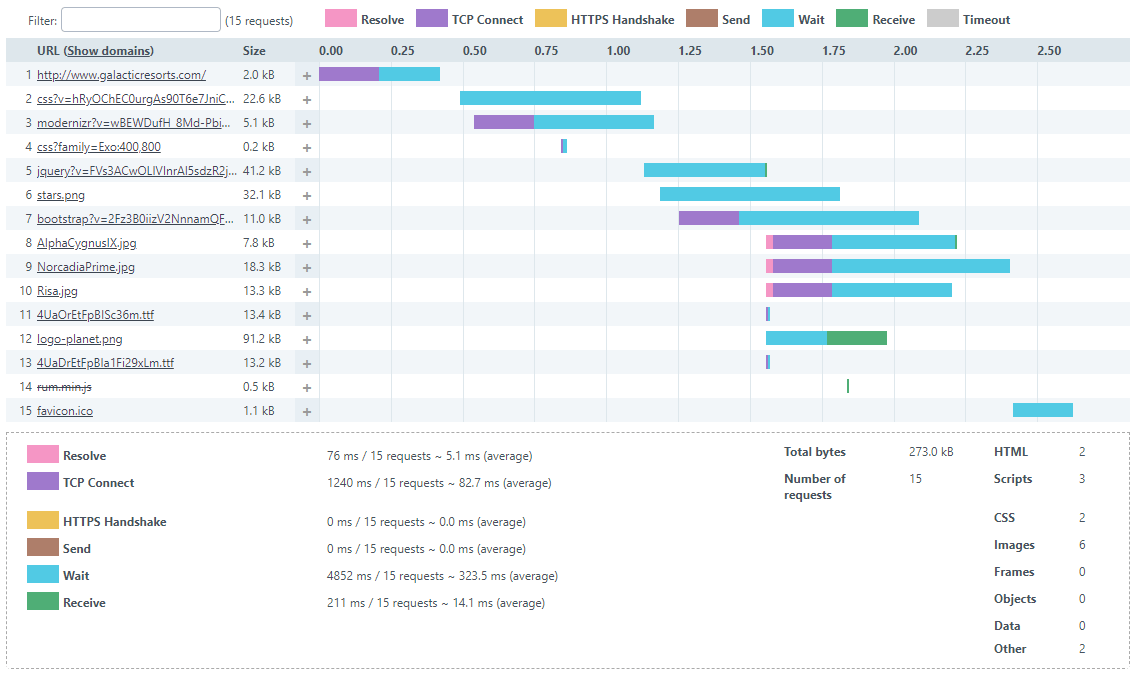We get it! You spent a lot of time working out your architecture, fine-tuning your user interface, and pouring money into launching and marketing your product or site, and you need to get more customers and keep the ones that you’ve got. Website performance is key to both retention and acquisition, so hopefully you took some time to ensure that you delivered a performant site or service.
Your site may have the best services, products, and content found on the web, but if your site or service’s performance is off even slightly, you’re hurting your brand and driving users to the competition. Performance is a big deal especially when it comes to mobile devices, so we’ve compiled a list of four reasons why you should care about website performance.
1. Better website performance leads to increased conversion rates
You offer a site or service for a reason, and when a user purchases your service, buys your product, signs up for a trial, subscribes to your mailing list, or consumes your content (with the ads), you have made a conversion that improves your key business metrics. Website speed is a factor in improving your conversion rates and raising consumer satisfaction. A study by Aberdeen found that for every second beyond the two second mark, conversion rates drop 7% and page views dropped by 11%.
- For e-commerce sites, a 7% drop in conversions means lost sales. For a site that generates $10,000.00 per day, a drop by 7% means a loss of over $2.5 million a year in for a page that loads in three seconds instead of two.
- For content sites, an 11% drop in page views means a serious impact on ad revenue. For example, a news site that gets 60 million unique viewers per month, with an average of 4 pages viewed per visitor, means an 11% drop in page views means 26,400,000 fewer pages viewed in a single month. If your site made $1.00 per 1000 page views, you’ve lost $31,680.00 per year due to a one second delay in page load time.
2. Better website performance improves brand awareness
Getting your name out there is a huge challenge. Search Engine Optimization (SEO) is a constant struggle for every brand. After all, who doesn’t want their content at the top of the search engine rankings? Many factors come into play to determine search engine rankings; one of the newer ranking factors is page performance. Google drops pages in the rankings that have slower load times. You might have highly relevant content, but Google will slide you down in the rankings for a page that has better performance. You also need to consider the impact of pogo sticking in your rankings.
If users click on a link and then go back to the search results page, they are pogo sticking. When a user hops into your content and jumps right back out, search engines assume that your content wasn’t relevant to the user’s search query. Search engines want to make sure the content they rank is spot on for the user’s search, so when the user bounces, they guess that your content isn’t any good for the search terms. Therefore, the more users that pogo stick on your content, the lower your site sinks in the rankings for the keywords. Many different things can cause pogo sticking beside irrelevant content such as pop-up ads and hard to find content. Also, if your page load time is poor (takes longer to load than two seconds), your users start hitting the back button. In fact, at 3 seconds you’ve sent 40% back to the search results. Google will attribute the high bounce rate to poor keyword relevance, and drop you in the rankings. The more people that pogo-stick on your page the further your page sinks in the search engine’s rankings.
You want people to find your content, and to do that you need your page to make it to the top of the search results. Therefore, for better SEO and improved brand awareness, you need to keep an eye on performance. You are not only striking out on one ranking factor but two: page speed and content relevance. Backlinko also reports that performance is a key factor when users use voice search on devices like Google Home.
3. Poor website performance destroys brand perception
Tammy Everts reported about a study conducted by Radware. The study focused on the effects that performance had on users’ brand perceptions when using a mobile device. In a three-part study, Radware had participants conduct standardized tasks on four e-commerce and travel sites using an iPhone. Half of the participants had a full speed Wi-Fi connection, while the other half had a throttled connection that reduced page load speed by 500ms. The effects of a 500ms delay on user perception were surprising, for those test participants subjected to the slower connection had a 26% increase in peak frustration and an 8% reduction in engagement. The slower experience led to brand perceptions described as “inelegant,” “boring,” “childlike,” and “tacky;” while the fast experience led people to perceive the sites in a positive light. Test participants reported their user experiences as positive, and they praised the usability and friendliness of the sites. The exact same content resulted in completely different user perceptions with the only difference being the page load time.
Google conducted a similar test. Greg Linden reported that Google received requests from users to see more than ten results on their searches per page, 30 to be exact. The change resulted in a page load time shift from .4 seconds to .9 seconds. The addition of 500ms to the search result load time resulted in unhappy users and a reduction of 20% in page views and ad revenue. Greg also reports that Amazon saw the same results in a study they conducted where as little as 100ms delay in page load times affected sales.
4. Faster performing websites gain a competitive edge
When users abandon your site due to performance problems, they don’t just give up their quest for products or content; they head to your competitors. If the competitor delivers a better experience, they win both the sale and the customer’s loyalty. To keep the sale and the customer’s loyalty and to give your brand a competitive edge, you need to have the faster loading site. However, to make sure your users know that your site offers the better experience they need to be able to see the difference.
To make sure your users are aware of how much better your site performs, you need to make sure your site is at least 20% faster than your competition when possible. You need to outperform your competitors by 20% based on the Weber–Fechner Law and Just-Noticeable Difference. Just-Noticeable Difference derives from the Weber-Fechner Law, and it simply states for people to notice the difference between two similar things requires a minimum difference of 20%. For example, if your page loads in 4 seconds and your competition loads in 3 seconds, your page needs to load in 2.4 seconds for users to see the difference (but of course you want to do even better than that). When your site is faster, your users perceive your brand as superior simply for the better user experience that faster loading pages bring.
Committing to website performance
Improving your site’s performance doesn’t end with site development. Maintaining a fast, quality user experience requires diligence, for your website or web service exists within a volatile environment where changes in infrastructure or content can have dramatic impacts on your site’s performance. For example, a major retailer during the week of Black Friday, changed out their slideshow on their homepage every 24 hours. On the Wednesday before Thanksgiving, they failed to optimize the images. The page that was relatively fast before was suddenly taking 19 seconds to load on a desktop! How many users and sales did they lose during that 24-hour prime shopping period? Situations like this happen to even the biggest sites, so you have to be continuously aware of your site’s performance to respond quickly to performance related problems. Uptrends offers you synthetic and real user monitoring solutions to protect you from issues like the example mentioned above and help you optimize your site’s performance.
Synthetic Web Performance Monitoring
Uptrends’ Full Page Check uses real browser technology (Chrome, IE, Firefox, and Phantom JS) to proactively test your site’s performance using our worldwide network of 179 checkpoints. The checkpoint generates the request and then tracks the responsiveness of your site. The Full Page Check tracks the times for each request as it loads your page into the browser, and you gain valuable performance metrics on every page element—even third-party elements. The data is arranged in an easy to read waterfall chart where you can quickly identify bottlenecks. You have the full contents of the request and the response for each element as well. If your page load times exceed your expectations, Uptrends notifies you via any one of our many alerting methods. An early warning often leads to fixing problems before they affect your users. The detailed reports make root-cause analysis simpler.

Real User Monitoring
While Synthetic Monitoring takes a proactive approach to routine monitoring, Real User Monitoring (RUM) uses a passive approach. Real User Monitoring records your actual users’ experience as they access your RUM enabled pages. RUM produces real-time aggregated real-user data that you can filter based on page view, device, browser, operating system, and location. You can see exactly how your users experience your site and optimize your site to accommodate them. We have two built-in dashboards making it easy to grab the data you need fast. For example, the interactive maps shown below tell you where your user concentrations are and how your load times compare from country to country (you can also filter down to states/provinces on many countries). The darker the color, the higher the page views or slower the load times for your domain. The reporting tools for Real User Monitoring are also packed with interactive tables and charts to help you see how the performance breakdowns for the various user environments. You can always create your own customized dashboards to show you the data that you most care about. You will know exactly where your users are and how they are connecting to your site, so you can add CDNs where necessary, and optimize based on their devices, operating systems, and browsers.

Conclusion
Your brand reputation and revenue depend on fast user experiences. A slow website can cost your business thousands or millions in revenue each year due to just a few milliseconds. 500ms is enough to reduce conversions, destroy user satisfaction, and drop you in the search engine rankings, but you can avoid all of that using a comprehensive DEM (Digital Experience Monitoring) plan. With an effective DEM that includes the Full Page Check and Real User Monitoring, you can avoid performance issues and learn about and respond to problems quickly. Stay aware of your site’s performance, and don’t let performance get in the way of your brand’s success. Invest in optimizing your site, and make sure it continues to meet your users’ expectations by monitoring with Uptrends. Our Business and Enterprise plans have all tools your DEM requires, so try Performance Monitoring and Real User Monitoring free for thirty days. We don’t require a credit card or a commitment. Your users and your revenue will thank you.





Leave a Reply